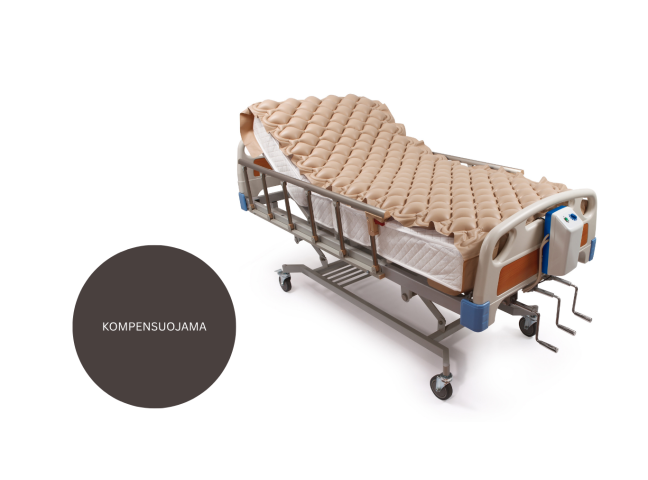What is blood pressure?
The heart supplies blood to all the organs and tissues of the body.
With each heartbeat, it pumps blood into the large blood vessels, circulating the blood through our body and putting pressure on the blood vessel walls.
Blood pressure is the pressure (pressure of blood) in the walls of blood vessels.
Blood pressure indicators consist of two values:
- Systolic blood pressure is the pressure when the heart beats - the heart muscles contract (squeeze) and pump oxygenated blood into the blood vessels.
- Diastolic blood pressure is the pressure in the blood vessels when the heart muscles relax. Diastolic pressure is always lower than systolic pressure.
Blood pressure is measured in millimetres of mercury (mmHg).
The readings are always given in pairs, with the upper (systolic) value first and then the lower (diastolic) value.
So someone with readings of 122/88 mmHg (often said to be "122 over 88") has systolic and distal readings:
- systolic blood pressure of 122 mmHg,
- a diastolic blood pressure of 88 mmHg.
How is blood pressure measured?
- It is important to measure your blood pressure more than once as it fluctuates throughout the day.
- Exercise, stress, pain and extreme heat or cold affect blood pressure. However, such a rise in blood pressure is temporary and quickly returns to normal. So, if your blood pressure is measured only once and it is high, it does not necessarily mean that it is always too high. Blood pressure readings taken at the doctor's surgery can also be misleading, as some people get agitated when they go to the doctor's office, which can lead to an increase in their blood pressure.
- To get reliable readings, blood pressure should be taken on several consecutive days and at rest. This means that you need to relax and wait for about 3-5 minutes before the measurement.
- It is important to sit correctly when taking your blood pressure and to position the sleeve of the meter at heart level.
- You can measure your blood pressure yourself using a digital blood pressure monitor.
- It is important that you do not drink a caffeinated beverage before taking your blood pressure and do not smoke within 30 minutes of the measurement.
- Sit quietly for five minutes before taking the measurement.
- During the measurement, sit in a chair and place your feet on the floor, with your elbow at about heart level.
- The inflatable cuff should completely cover at least 80% of your upper arm and the cuff should be placed on bare skin.
- Do not talk during the measurement.
- Take two measurements, with a short break between measurements. If the reading differs by 5 or more points, take a third measurement.
What is normal blood pressure and when is high blood pressure?
Blood pressure is measured on different days and at rest.
If the readings are too high, you are considered to have high blood pressure, even if only one of the two - systolic or diastolic - is high. The medical term for high blood pressure is hypertension. In adults, blood pressure is considered normal when the systolic value is 120 mmHg and the diastolic value is 80 mmHg.
When taking blood pressure for the first time, it makes sense to measure the blood pressure in both arms, as sometimes it is high on only one side. The higher values are always used to measure blood pressure. Afterwards, it is sufficient to measure the blood pressure only in the arm with the higher reading.
A person is considered to have high blood pressure if the systolic value is greater than 120 mmHg, the diastolic value is greater than 80 mmHg, or if both are greater than these values.
| Optimal blood pressure | systolic less than 120 mmHg and diastolic less than 80 mmHg |
| High blood pressure | systolic greater than 120 mmHg and/or diastolic greater than 80 mmHg |
| Low blood pressure | systolic less than 90 mmHg and/or diastolic less than 60 mmHg |
Increased blood pressure is usually not noticeable. Only if it is particularly high can dizziness or heaviness sometimes occur. Over time, high blood pressure increases the risk of developing cardiovascular problems such as heart attacks, strokes, heart and kidney failure. So if you or your doctor think you have high blood pressure, it is important to have your blood pressure checked regularly. If the readings are repeatedly too high, there are several different ways to lower your blood pressure and reduce the risk of long-term health consequences.
Low blood pressure, or hypotension, is diagnosed when a blood pressure monitor reads less than 90/60 mmHg. However, it should not be forgotten that blood pressure also depends on a person's age, physical condition and existing diseases, so these indicators are not absolute and can vary. If a person's blood pressure is always low and they do not feel it, there is nothing to worry about. Usually, blood pressure varies during the day, falling, for example, during sleep, or rising when you wake up, due to physical activity, stress, fright or other strong emotions. Our body is adapted to constant fluctuations in blood pressure and after a while it naturally restores blood pressure to normal.
Blood pressure standard
The National High Blood Pressure Education Program Coordinating Committee has developed a blood pressure standard that classifies blood pressure ranges into 4 tiers (see The Seventh Report of the Joint National Committee on Prevention, Detection, Evaluation, and Treatment of High Blood Pressure - Complete Report JNC-7, 2004). This blood pressure classification is based on historical data and cannot be applied directly to any particular patient.
It is very important that you consult your doctor regularly. Your doctor will tell you what blood pressure is normal for you, as well as what blood pressure is dangerous for you. To ensure reliable blood pressure monitoring and a reference point, it is advisable to keep the information as long as possible.
Questions?
If you have any questions, please contact Rehastar.com staff by phone on weekdays 08:00 - 17:00 or by email at any time and we will do our best to answer you as soon as possible.
Email: info@rehastar.com
Phone: +370 626 11553







